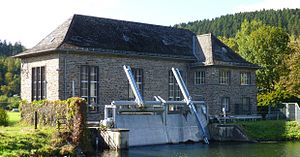Ehreshoven I power station
| Ehreshoven I power station | ||
|---|---|---|
| Power plant building | ||
| location | ||
|
|
||
| Coordinates | 50 ° 58 '39 " N , 7 ° 20' 45" E | |
| country | Germany / NRW | |
| place | Ehreshoven | |
| Waters | Agger | |
| power plant | ||
| operator | Aggerkraftwerke GmbH & Co. KG | |
| Start of planning | 1923 | |
| Start of operation | 1932 | |
| technology | ||
| Average height of fall |
6.50 m | |
| Standard work capacity | 2.515 million kWh / year | |
| Others | ||
The Ehreshoven I power station is a hydropower station in Ehreshoven . The facility is a listed building.
Location and description
The facilities include a power station building and a weir about 150 meters upstream . They dam the Agger , starting from the center of Loope , to a lake about 1 kilometer long. The storage volume is 280,000 m³. The drop height of the water is 6.50 meters. The average standard energy capacity of the two machines is 2515 megawatt hours per year.
The weir divides the Agger into two arms, which flow together again behind the Ehreshoven reservoir and the Ehreshoven II power station .
history
The council of the municipality of Engelskirchen, which at the time belonged to the district of Wipperfürth , considered using the Agger to generate electrical energy before the 1920s, but either had insufficient capital or was prevented from implementing corresponding plans by the inflation. The county Gummersbach handed instead on August 24, 1923 the District Committee Cologne lodge an application in which belonging to Engelskirchen Broich to build a power plant. The Ermen & Engels company and the Engelskirchen community responded in February 1924 with their own application.
On September 2, 1924, the Cologne district committee demanded improvements and postponed a decision on the construction of a power plant in Ehreshoven. At the same time, he rejected an alternative application from Wasserkraft GmbH Overath and the Ehreshoven monastery administration to build a power plant here. The district of Gummersbach, which originally wanted to involve the communities of Engelskirchen and Ründeroth and the district of Wipperfürth, now refrained from participating due to their own failed applications and counter-projects. After the district electricity works Dieringhausen had allocated special quotas for electricity to the community of Engelskirchen, the community of Engelskirchen withdrew its own applications and objections to the construction of the plant in October 1925. As part of an appeal against the construction of the power plant in July 1926, the water level was lowered by 1.60 meters in order not to endanger the ground, sewage and drinking water supplies.
The responsible supervisory authority ordered that a dam should be built between the weir and the power house. This was to ensure that in the event of a fault in the weir, the water could flow off over the top of the dam. This is the reason for the unusual design of the system, which can also be found at the Grünscheid electricity works , which was also built at this time. The construction of the power plant was completed in 1932 and put into operation by the Dieringhausen district power station. The latter sold the plant in 1935 to RWE , which in 2002 sold it to a private operator.
Today the power plant is almost irrelevant for the electricity production of the Oberbergischer Kreis .
Individual evidence
- ^ Monument protection website of the Engelskirchen community. Retrieved November 14, 2015
- ^ Christian Stiefelhagen: Construction of the dams and hydroelectric power stations . In: Heinrich Lüdenbach: Loope . A home book. Ed .: Citizens and Beautification Association Loope e. V. Joh. Heider Verlag GmbH, Bergisch Gladbach 2012, ISBN 978-3-87314-473-6 . , Page 205
- ^ Christian Stiefelhagen: Construction of the dams and hydroelectric power stations . In: Heinrich Lüdenbach: Loope . A home book. Ed .: Citizens and Beautification Association Loope e. V. Joh. Heider Verlag GmbH, Bergisch Gladbach 2012, ISBN 978-3-87314-473-6 . , Pages 200–201
- ^ Christian Stiefelhagen: Construction of the dams and hydroelectric power stations . In: Heinrich Lüdenbach: Loope . A home book. Ed .: Citizens and Beautification Association Loope e. V. Joh. Heider Verlag GmbH, Bergisch Gladbach 2012, ISBN 978-3-87314-473-6 . , Pages 201-202
- ^ Christian Stiefelhagen: Construction of the dams and hydroelectric power stations . In: Heinrich Lüdenbach: Loope . A home book. Ed .: Citizens and Beautification Association Loope e. V. Joh. Heider Verlag GmbH, Bergisch Gladbach 2012, ISBN 978-3-87314-473-6 . , Page 202
- ^ Christian Stiefelhagen: Construction of the dams and hydroelectric power stations . In: Heinrich Lüdenbach: Loope . A home book. Ed .: Citizens and Beautification Association Loope e. V. Joh. Heider Verlag GmbH, Bergisch Gladbach 2012, ISBN 978-3-87314-473-6 . , Page 204
- ^ Christian Stiefelhagen: Construction of the dams and hydroelectric power stations . In: Heinrich Lüdenbach: Loope . A home book. Ed .: Citizens and Beautification Association Loope e. V. Joh. Heider Verlag GmbH, Bergisch Gladbach 2012, ISBN 978-3-87314-473-6 . , Pp. 204-205
- ^ Christian Stiefelhagen: Construction of the dams and hydroelectric power stations . In: Heinrich Lüdenbach: Loope . A home book. Ed .: Citizens and Beautification Association Loope e. V. Joh. Heider Verlag GmbH, Bergisch Gladbach 2012, ISBN 978-3-87314-473-6 . , Page 205


